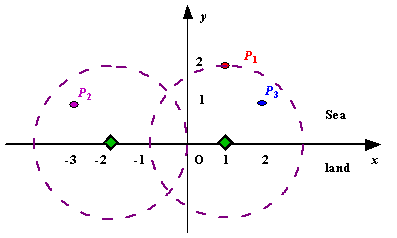Language:
Radar Installation
| Time Limit: 1000MS | Memory Limit: 10000K | |
| Total Submissions: 42461 | Accepted: 9409 |
Description
Assume the coasting is an infinite straight line. Land is in one side of coasting, sea in the other. Each small island is a point locating in the sea side. And any radar installation, locating on the coasting, can only cover d distance, so an island in the sea can be covered by a radius installation, if the distance between them is at most d.
We use Cartesian coordinate system, defining the coasting is the x-axis. The sea side is above x-axis, and the land side below. Given the position of each island in the sea, and given the distance of the coverage of the radar installation, your task is to write a program to find the minimal number of radar installations to cover all the islands. Note that the position of an island is represented by its x-y coordinates.

Figure A Sample Input of Radar Installations
We use Cartesian coordinate system, defining the coasting is the x-axis. The sea side is above x-axis, and the land side below. Given the position of each island in the sea, and given the distance of the coverage of the radar installation, your task is to write a program to find the minimal number of radar installations to cover all the islands. Note that the position of an island is represented by its x-y coordinates.

Figure A Sample Input of Radar Installations
Input
The input consists of several test cases. The first line of each case contains two integers n (1<=n<=1000) and d, where n is the number of islands in the sea and d is the distance of coverage of the radar installation. This is followed by n lines each containing two integers representing the coordinate of the position of each island. Then a blank line follows to separate the cases.
The input is terminated by a line containing pair of zeros
The input is terminated by a line containing pair of zeros
Output
For each test case output one line consisting of the test case number followed by the minimal number of radar installations needed. "-1" installation means no solution for that case.
Sample Input
3 2 1 2 -3 1 2 1 1 2 0 2 0 0
Sample Output
Case 1: 2 Case 2: 1

1 #include<stdio.h> 2 #include<string.h> 3 #include<math.h> 4 #include<algorithm> 5 #include<iostream> 6 #include<stack> 7 #include<math.h> 8 using namespace std; 9 10 struct node 11 { 12 double start; 13 double end; 14 }coor[1001];//记录每个区间的端点 15 int cmp(const struct node a,const struct node b) 16 { 17 return a.start < b.start; 18 } 19 int t,r; 20 stack <node> st;//用栈存每个区间, 21 22 int cal(int ans) 23 { 24 while(!st.empty()) 25 st.pop(); 26 for(int i = t-1; i >= 0; i--) 27 st.push(coor[i]); 28 while(st.size() >= 2)//当栈中至少存在两个区间时 29 { 30 struct node tmp1 = st.top(); 31 st.pop(); 32 struct node tmp2 = st.top(); 33 if(tmp1.end >= tmp2.start)//当取出的两个区间有公共部分时 34 { 35 st.pop();//tmp2出栈 36 struct node tmp; 37 tmp.start = max(tmp1.start, tmp2.start);//注意取公共部分时,起始点取较大者 38 tmp.end = min(tmp1.end, tmp2.end);//终点取较小者 39 st.push(tmp);//将公共部分入栈 40 ans--;//每两个区间交一次,雷达个数减一次 41 } 42 } 43 return ans; 44 } 45 int main() 46 { 47 48 int cor_x[1001],cor_y[1001]; 49 double add; 50 int cnt = 1; 51 while(~scanf("%d %d",&t,&r)) 52 { 53 int ok = 1;//判断小岛的坐标是否合法, 54 if(t == 0 && r == 0) break; 55 for(int i = 0; i < t; i++) 56 { 57 scanf("%d %d",&cor_x[i],&cor_y[i]); 58 if(cor_y[i] > r)//若小岛纵坐标大于半径则不合法 59 ok = 0; 60 } 61 if(ok == 0) 62 { 63 printf("Case %d: -1 ", cnt++); 64 continue; 65 } 66 for(int i = 0; i < t; i++) 67 { 68 //以每个小岛为圆心,r为半径画圆,coor[]存该圆与x轴相交的区间 69 add = sqrt(r*r-cor_y[i]*cor_y[i]); 70 coor[i].start = cor_x[i] - add; 71 coor[i].end = cor_x[i] + add; 72 } 73 sort(coor,coor+t,cmp);//对这些区间按起始点从小到大排序 74 int ans = t; 75 ans = cal(ans); 76 printf("Case %d: %d ",cnt++,ans); 77 } 78 return 0; 79 }
